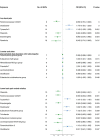Genetically predicted causal effects of gut microbiota on spinal pain: a two-sample Mendelian randomization analysis
- PMID: 38591041
- PMCID: PMC10999687
- DOI: 10.3389/fmicb.2024.1357303
Genetically predicted causal effects of gut microbiota on spinal pain: a two-sample Mendelian randomization analysis
Abstract
Background: Observational studies have hinted at a correlation between the gut microbiota and spinal pain (SP). However, the impact of the gut microbiota on SP remains inconclusive.
Methods: In this study, we employed a two-sample Mendelian randomization (MR) analysis to explore the causal relationship between the gut microbiota and SP, encompassing neck pain (NP), thoracic spine pain (TSP), low back pain (LBP), and back pain (BP). The compiled gut microbiota data originated from a genome-wide association study (GWAS) conducted by the MiBioGen consortium (n = 18,340). Summary data for NP were sourced from the UK Biobank, TSP from the FinnGen Biobank, and LBP from both the UK Biobank and FinnGen Biobank. Summary data for BP were obtained from the UK Biobank. The primary analytical approach for assessing causal relationships was the Inverse Variance Weighted (IVW) method, supplemented by various sensitivity analyses to ensure result robustness.
Results: The IVW analysis unveiled 37 bacterial genera with a potential causal relationship to SP. After Benjamini-Hochberg corrected test, four bacterial genera emerged with a strong causal relationship to SP. Specifically, Oxalobacter (OR: 1.143, 95% CI 1.061-1.232, P = 0.0004) and Tyzzerella 3 (OR: 1.145, 95% CI 1.059-1.238, P = 0.0007) were identified as risk factors for LBP, while Ruminococcaceae UCG011 (OR: 0.859, 95% CI 0.791-0.932, P = 0.0003) was marked as a protective factor for LBP, and Olsenella (OR: 0.893, 95% CI 0.839-0.951, P = 0.0004) was recognized as a protective factor for low back pain or/and sciatica. No significant heterogeneity or horizontal pleiotropy was observed through alternative testing methods.
Conclusion: This study establishes a causal relationship between the gut microbiota and SP, shedding light on the "gut-spine" axis. These findings offer novel perspectives for understanding the etiology of SP and provide a theoretical foundation for potential interventions targeting the gut microbiota to prevent and treat SP.
Keywords: Mendelian randomization; back pain; causality; gut microbiota; low back pain; neck pain; spinal pain; thoracic spine pain.
Copyright © 2024 Hong, Chen, Zhou, Huang, Tian, Hu, Yu, Wu, Yang, Lv and Lv.
Conflict of interest statement
The authors declare that the research was conducted in the absence of any commercial or financial relationships that could be construed as a potential conflict of interest.
Figures





Similar articles
-
Genetically supported causality between gut microbiota, gut metabolites and low back pain: a two-sample Mendelian randomization study.Front Microbiol. 2023 Apr 14;14:1157451. doi: 10.3389/fmicb.2023.1157451. eCollection 2023. Front Microbiol. 2023. PMID: 37125171 Free PMC article.
-
Assessing the Genetic Causal Effects Between Blood Metabolites and Spinal Pain: A Bidirectional Two-Sample Mendelian Randomization Study.J Pain Res. 2024 Nov 20;17:3897-3918. doi: 10.2147/JPR.S487156. eCollection 2024. J Pain Res. 2024. PMID: 39583190 Free PMC article.
-
Gut microbiota and intervertebral disc degeneration: a bidirectional two-sample Mendelian randomization study.J Orthop Surg Res. 2023 Aug 14;18(1):601. doi: 10.1186/s13018-023-04081-0. J Orthop Surg Res. 2023. PMID: 37580794 Free PMC article.
-
Causal effects of specific gut microbiota on musculoskeletal diseases: a bidirectional two-sample Mendelian randomization study.Front Microbiol. 2023 Aug 17;14:1238800. doi: 10.3389/fmicb.2023.1238800. eCollection 2023. Front Microbiol. 2023. PMID: 37664120 Free PMC article.
-
Exploring the potential causal relationship between gut microbiota and heart failure: A two-sample mendelian randomization study combined with the geo database.Curr Probl Cardiol. 2024 Feb;49(2):102235. doi: 10.1016/j.cpcardiol.2023.102235. Epub 2023 Nov 30. Curr Probl Cardiol. 2024. PMID: 38040216 Review.
Cited by
-
Causal relationships of gut microbiota and blood metabolites with ovarian cancer and endometrial cancer: a Mendelian randomization study.J Ovarian Res. 2025 Mar 13;18(1):54. doi: 10.1186/s13048-025-01630-5. J Ovarian Res. 2025. PMID: 40082983 Free PMC article.
-
Causal relationships between metabolic syndrome, plasma metabolites, and female reproductive diseases: insights from a two-step mendelian randomization approach.Nutr Metab (Lond). 2025 Jun 13;22(1):60. doi: 10.1186/s12986-025-00955-8. Nutr Metab (Lond). 2025. PMID: 40514674 Free PMC article.
-
Causal relationship between immune cells and pulmonary arterial hypertension: Mendelian randomization analysis.Medicine (Baltimore). 2024 Sep 13;103(37):e39670. doi: 10.1097/MD.0000000000039670. Medicine (Baltimore). 2024. PMID: 39287266 Free PMC article.
References
LinkOut - more resources
Full Text Sources
Miscellaneous

